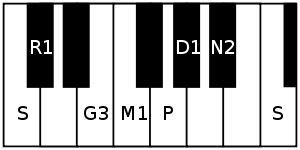Vakulabharanam
| Carnatic music |
|---|
Tanjavur-style Tambura |
| Concepts |
| Compositions |
| Instruments |
|
Vakulabharanam (pronounced vakuḷābharaṇam) is a rāgam in Carnatic music (musical scale of South Indian classical music). It is the 14th melakarta rāgam in the 72 melakarta rāgam system of Carnatic music. It is called Dhātivasantabhairavi[1][2] or Vātivasantabhairavi[3] in Muthuswami Dikshitar school of Carnatic music.
Structure and Lakshana

It is the 2nd rāgam in the 3rd chakra Agni. The mnemonic name is Agni-Sri. The mnemonic phrase is sa ra gu ma pa dha ni.[1] Its ārohaṇa-avarohaṇa structure (ascending and descending scale) is as follows (see swaras in Carnatic music for details on below notation and terms):
Shuddha rishabham, antara gandharam, shuddha madhyamam, shuddha dhaivatham and kaisiki nishadham are the swaras used in this scale. As this scale is a melakarta rāgam, by definition it is a sampoorna rāgam (has all seven notes in ascending and descending scale). It is the shuddha madhyamam equivalent of Nāmanārāyaṇi, which is the 50th melakarta scale.
Asampurna Melakarta
Vātivasantabhairavi is the 14th Melakarta in the original list compiled by Venkatamakhin. The notes used in the scale are the same, but the descending scale has notes used in zig-zag manner (vakra prayoga).[4]
Janya rāgams
Vakulabharanam has a few minor janya rāgams (derived scales) associated with it, of which Vasantabhairavi is heard occasionally in concerts. See List of janya rāgams for full list of rāgams associated with Vakulabharanam.
Compositions
Here are a few common compositions sung in concerts, set to Vakulabharanam.
- Gowrinatham by Oottukkadu Venkata Kavi
- Ye ramuni nammitino by Thyagaraja
- Nambinen ayya by Koteeswara Iyer
- Rama namamai by Mysore Vasudevachar
- KumĀruni valenu kĀvavĒ by Dr. M. Balamuralikrishna
- Saadhu tada, a composition by Maharaja Swati Tirunal of Travancore, has been tuned in Vakulabharanam by Prince Rama Varma.
Related rāgams
This section covers the theoretical and scientific aspect of this rāgam.
Vakulabharanam's notes when shifted using Graha bhedam, yields 2 major melakarta rāgams, namely Keeravani and Hemavati along with 1 minor melakarta rāgam Kosalam. Graha bhedam is the step taken in keeping the relative note frequencies same, while shifting the shadjam to the next note in the rāgam. For further details and an illustration refer Graha bhedam on Keeravani.
References
- 1 2 Ragas in Carnatic music by Dr. S. Bhagyalekshmy, Pub. 1990, CBH Publications
- ↑ Raganidhi by P. Subba Rao, Pub. 1964, The Music Academy of Madras
- ↑ Sri Muthuswami Dikshitar Keertanaigal by Vidwan A. Sundaram Iyer, Pub. 1989, Music Book Publishers, Mylapore, Chennai, India
- ↑ Shree Muthuswami Dikshitar Keerthanaigal, by A Sundaram Iyer, Music Book Publishers, Mylapore, Chennai